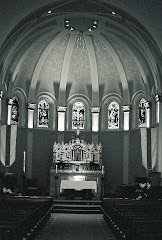Holy Cross Parish is very beautiful. Our rerdos(back altar) is great. Our stained glass windows are stunning. One of the pieces art that is very important in our parish is the Icon of “Our Lady of Perpetual Help” on the wall of the church.
This piece of art is a copy of a Byzantine Icon originally painted in the 13th Century. It is particular appropriate for our parish because it was originally known as “Our Lady of the Passion”.
On the left is the Archangel Michael who is carrying the lance and the sponge of the crucifixion of Jesus. On the right is the Archangel Gabriel carrying the cross and the nails.
Look at the image of Jesus. Notice that he NOT looking at Mary. He is NOT looking at us. He is staring at the Angel carrying the cross and the nails. He is holding tightly to Mary his mother. Notice that his shoe fell off. This implies that he ran to his mother and leapt into her arms when he was confronted with his future death on the cross presented to him by the angels. He ran to the arms is his mother because he knew that someday he would suffer and die on the cross.
Now look at the image of Mary. She dominates the picture because she is looking straight at YOU(the viewer). She is not looking at Jesus, or at heaven, or at the angels. She is looking at you as if to say: Here is something VERY important. She looks as if to say: My son ran to me for refuge, so can you. There is a star on Mary’s forehead: She is the star that leads to Jesus. She is pointing at her son, Jesus Christ. Both Mary and Jesus are wearing clothes of royalty. The Greek initials on top read: Mother of God, Michael Archangel, Gabriel Archangel, and Jesus Christ.
Mary knows there are many things in our lives that are dangerous and terrifying, and that we need someone to turn to in times of suffering and dread. She offers us the same comfort and love she gave to Jesus. She tells us to run to her as fast as Jesus did, so fast that we don’t even think about what we wear or how we go, just so we get there. Then Mary will point to Jesus, our lord and savior.
I hope you are able to spend some time in prayer meditating on this beautiful icon, and being drawn in the love Mary had for her Son, and in that way you can love Jesus as well. Beautiful art should raise our hearts and minds to God.
peace











